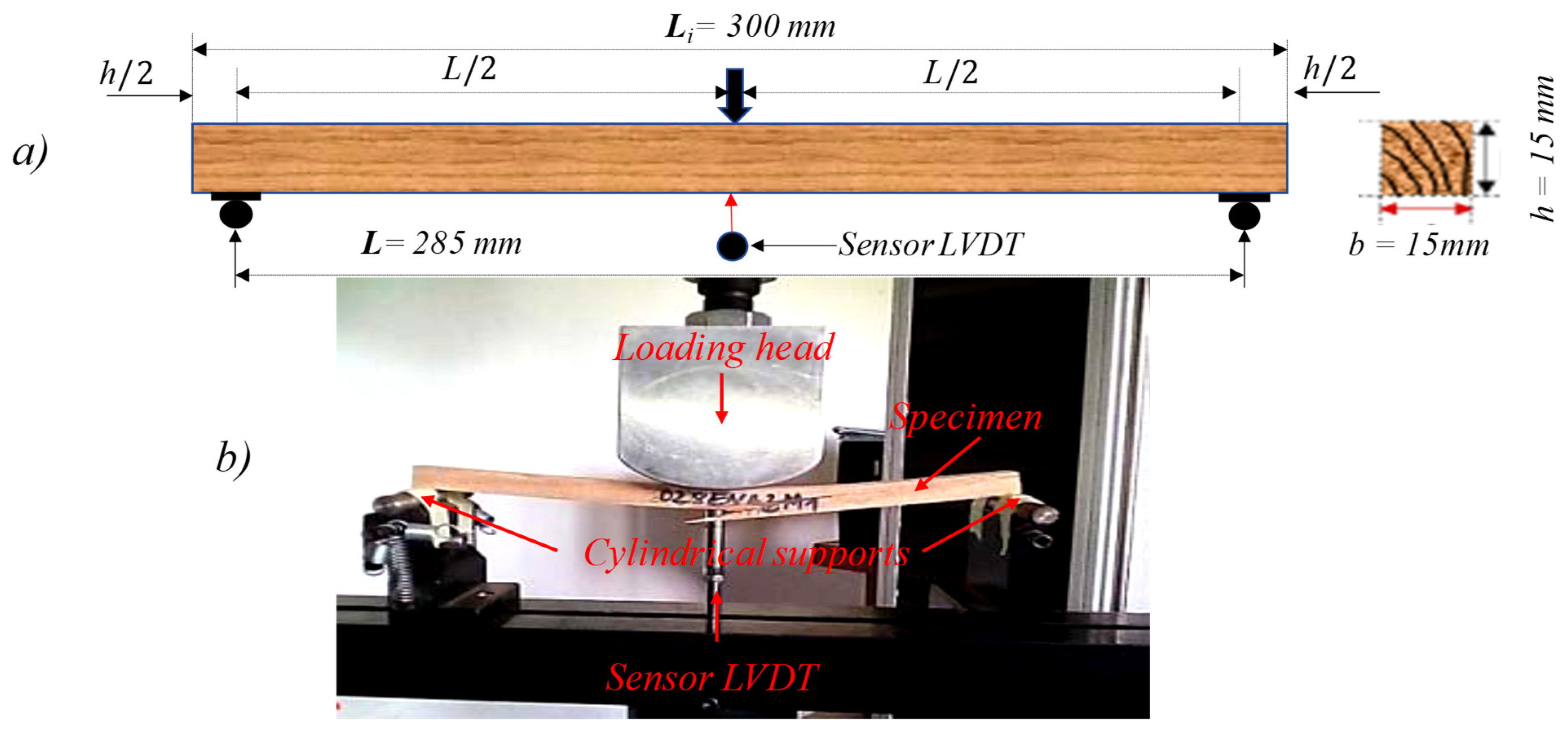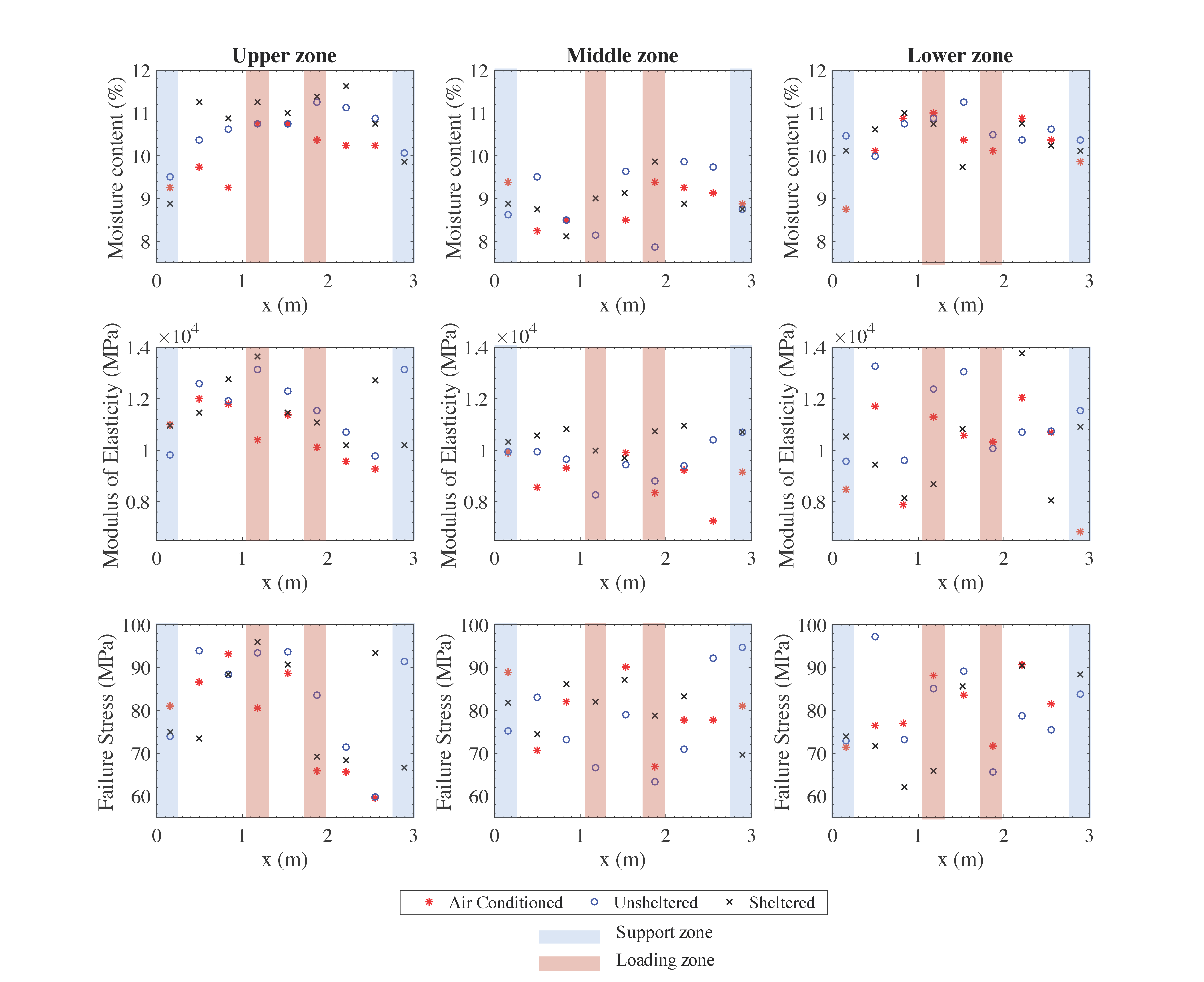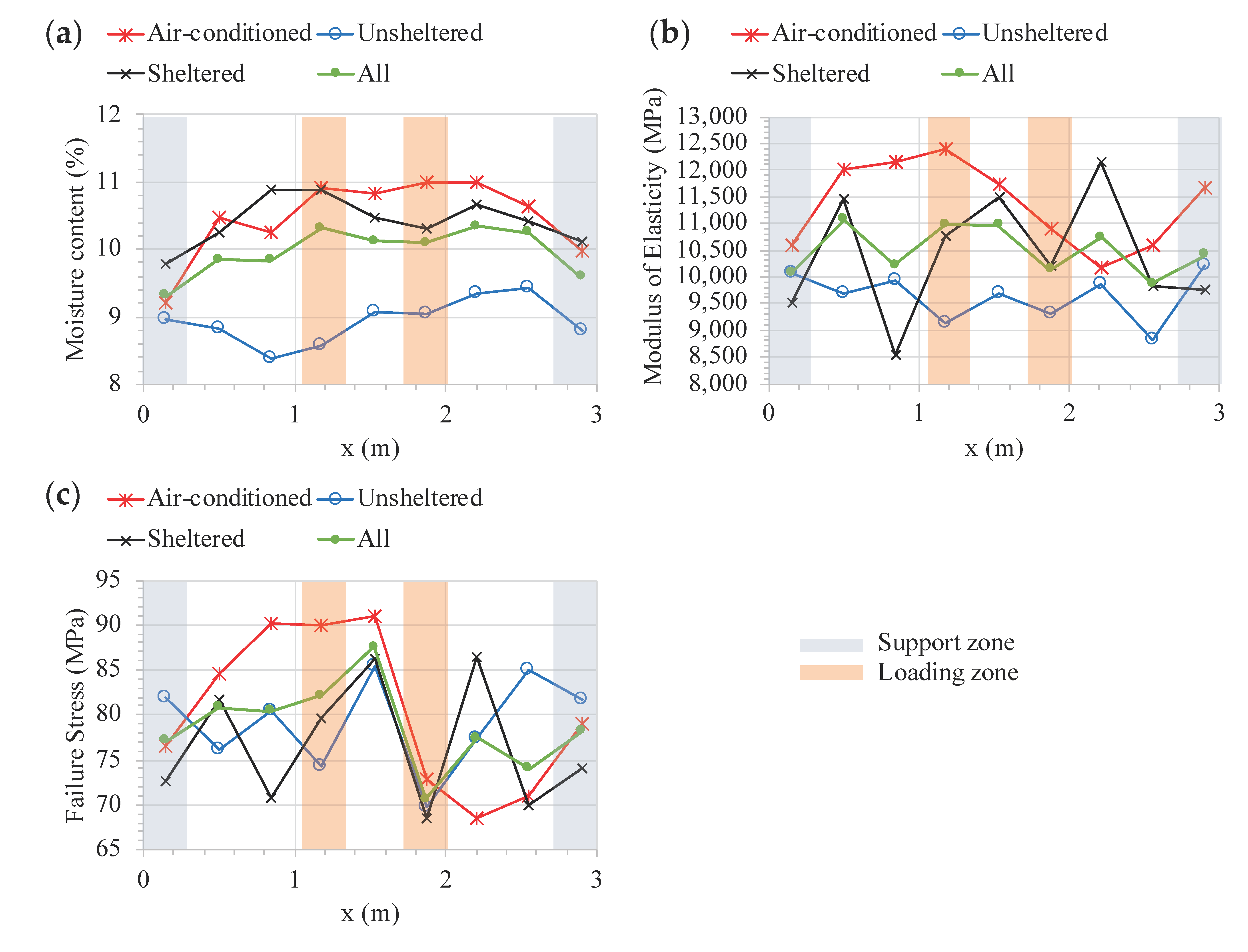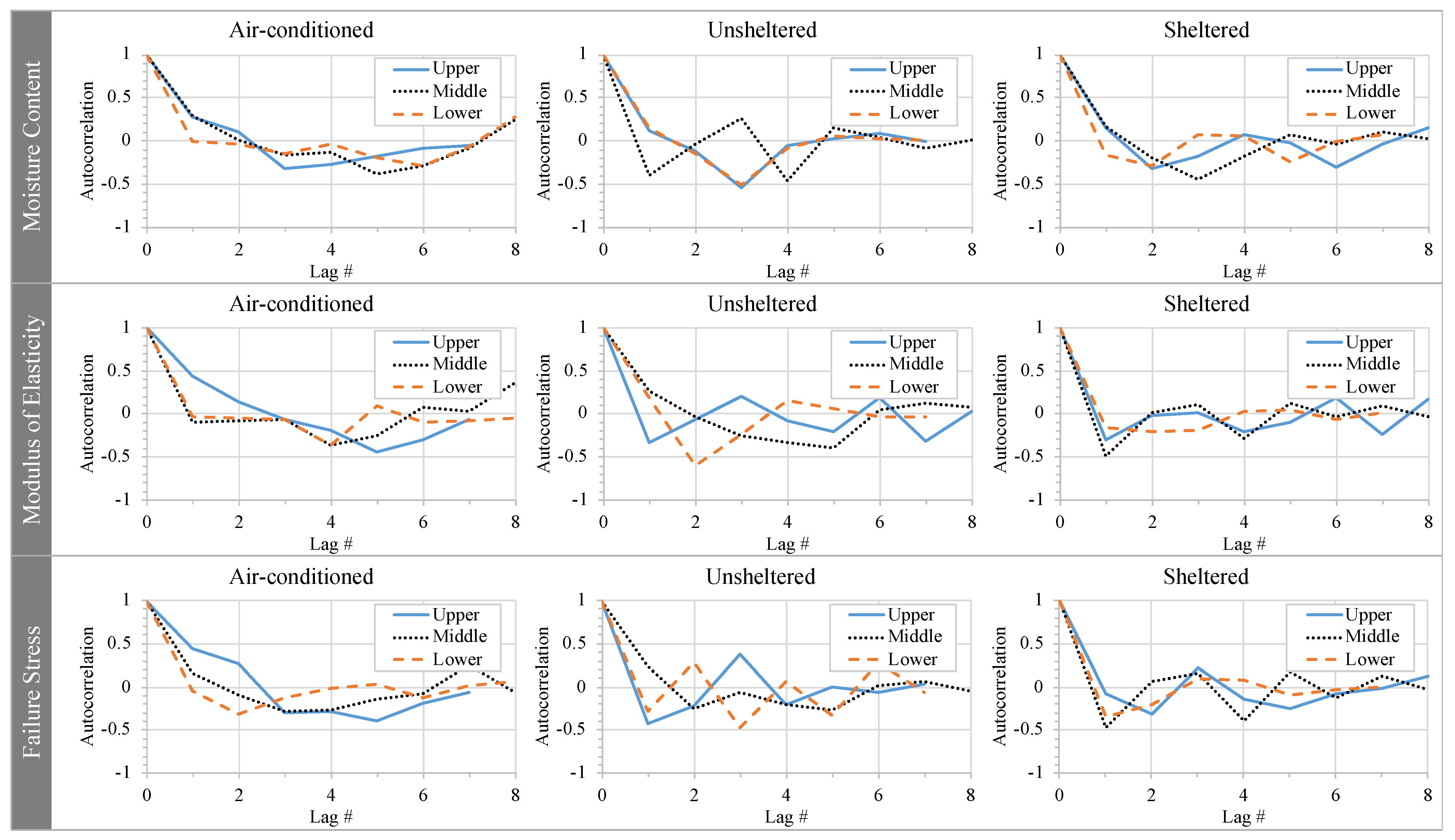Spatial Variability of Ozigo Wood Beams under Long-Term Loadings in Various Environmental Exposures
Abstract
1. Introduction
2. Materials and Methods
2.1. Materials
2.2. Methods
2.2.1. Experimental Protocol
2.2.2. Assessment of Mechanical Properties
2.2.3. Statistical and Spatial Variability Analyses
3. Results and Discussions
3.1. Statistical Analysis of Measured Data
3.2. Spatial Variability Analysis
4. Conclusions
Author Contributions
Funding
Institutional Review Board Statement
Informed Consent Statement
Data Availability Statement
Acknowledgments
Conflicts of Interest
Abbreviations
| Force increment | |
| Increase in the arrow | |
| b | Thickness of the specimen |
| E12% | Modulus of elasticity at 12% of the Moisture Content |
| Fmax | Maximum force |
| FS | Failure Stress |
| h | Height of the specimen |
| l | Length of the specimen |
| LZ | Lower zone |
| MC | Moisture Content |
| MOE | Modulus of elasticity |
| MZ | Middle zone |
| RH | Relative humidity |
| T | Temperature |
| UZ | Upper zone |
| Modulus of elasticity corresponding to the Moisture Content | |
| Internal moisture content of each specimen |
References
- Bayol, N.; Anquetil, F.; Bile, C.; Bollen, A.; Bousquet, M.; Castadot, B.; Meunier, Q. Timber industry and natural forest man-agement: Tropical timber and central African forests in the face of market developments. For. Congo Basin State For. 2013, 2013, 47–66. [Google Scholar]
- Ikogou, S.; Pambou Nziengui, C.F.; Moutou Pitti, R.; Ekomy Ango, S. Experimental study of tropical wood under cyclic com-pressive loading for sustainable constructions. In Proceedings of the World Conference of Timber Engineering (WCTE), Vienna, Austria, 22–25 August 2016. [Google Scholar]
- Allan, K.; Phillips, A. Comparative Cradle-to-Grave Life Cycle Assessment of Low and Mid-Rise Mass Timber Buildings with Equivalent Structural Steel Alternatives. Sustainability 2021, 13, 3401. [Google Scholar] [CrossRef]
- Tahmasebinia, F.; Ma, Y.; Joshua, K.; Sepasgozar, S.; Yu, Y.; Li, J.; Sepasgozar, S.; Marroquin, F. Sustainable Architecture Creating Arches Using a Bamboo Grid Shell Structure: Numerical Analysis and Design. Sustainability 2021, 13, 2598. [Google Scholar] [CrossRef]
- Pambou Nziengui, C.F.; Ikogou, S.; Moutou Pitti, R. Impact of cyclic compressive loading and moisture content on the me-chanical behavior Aucoumea Klaineana Pierre. Wood Mater. Sci. Eng. 2017, 13, 190–196. [Google Scholar] [CrossRef]
- Grubben, G.J.H.; Denton, O.A. Plan Ressources of Tropical Africa, Timbers 1; Backhuys Publishers: Leiden, The Netherlands, 2008; pp. 203–204. [Google Scholar]
- Tran, T.-B.; Bastidas-Arteaga, E.; Aoues, Y.; Nziengui, C.P.; Hamdi, S.; Pitti, R.M.; Fournely, E.; Schoefs, F.; Chateauneuf, A. Reliability assessment and updating of notched timber components subjected to environmental and mechanical loading. Eng. Struct. 2018, 166, 107–116. [Google Scholar] [CrossRef]
- Pambou Nziengui, C.F. Cracking of Wood in Variable Climate under Long-Term Loads: Applications to European and Gabo-nese Species. Ph.D. Thesis, Clermont Auvergne University, Clermont-Ferrand, France, 2019. [Google Scholar]
- Chassagne, P.; Saïd, E.B.; Jullien, J.F.; Galimard, P. Three Dimensional Creep Model for Wood under Variable Humidity-Numerical Analyses at Different Material Scales. Mech. Time-Dependent Mater. 2005, 9, 1–21. [Google Scholar] [CrossRef]
- Pittet, V. Experimental Study of Mechanosorptive Couplings in Wood Subjected to Controlled Hygrometric Variations under Long Duration Loadings. Ph.D. Thesis, Ecole Polytechnique Federal de Lausanne, Lausanne, Switzerland, 1996. [Google Scholar]
- Saifouni, O. Modeling of Rheological Effects in Materials: Application to the Mechanosorptive Behavior of Wood. Solid Me-chanics. Ph.D. Thesis, Blaise Pascal University, Clermont-Ferrand, France, 2014. [Google Scholar]
- Toratti, T.; Morlier, P. Long-term creep of bent wood in structural size. Mater. Struct. 1995, 28, 284–292. [Google Scholar] [CrossRef]
- Moshtaghin, A.F.; Franke, S.; Keller, T.; Vassilopoulos, A.P. Experimental characterization of longitudinal mechanical properties of clear timber: Random spatial variability and size effects. Constr. Build. Mater. 2016, 120, 432–441. [Google Scholar] [CrossRef]
- Natterer, J.; Sandoz, J.-L.; Rey, M. Wood Construction: Materials, Technology and Sizing; Edition Presses Polytechniques and Universitaires Romandes, Civil Engineering Treaty: Lausanne, Switzerland, 2004; p. 13. [Google Scholar]
- Vořechovský, M. Interplay of size effects in concrete specimens under tension studied via computational stochastic fracture mechanics. Int. J. Solids Struct. 2007, 44, 2715–2731. [Google Scholar] [CrossRef]
- Sriramula, S.; Chryssanthopoulos, M.K. An experimental characterisation of spatial variability in GFRP composite panels. Struct. Saf. 2013, 42, 1–11. [Google Scholar] [CrossRef]
- Ravahatra, N.R.; Duprat, F.; Schoefs, F.; De Larrard, T.; Bastidas-Arteaga, E. Assessing the Capability of Analytical Carbonation Models to Propagate Uncertainties and Spatial Variability of Reinforced Concrete Structures. Front. Built Environ. 2017, 3, 1–9. [Google Scholar] [CrossRef][Green Version]
- Clerc, R.; Oumouni, M.; Schoefs, F. SCAP-1D: A Spatial Correlation Assessment Procedure from unidimensional discrete data. Reliab. Eng. Syst. Saf. 2019, 191, 106498. [Google Scholar] [CrossRef]
- Ravahatra, N.R.; Bastidas-Arteaga, E.; Schoefs, F.; Duprat, F.; De Larrard, T.; Oumouni, M. Characterisation and propagation of spatial fields in deterioration models: Application to concrete carbonation. Eur. J. Environ. Civ. Eng. 2019, 1–27. [Google Scholar] [CrossRef]
- Li, C.; Der Kiureghian, A. Optimal Discretization of Random Fields. J. Eng. Mech. 1993, 119, 1136–1154. [Google Scholar] [CrossRef]
- Loève, M. Probability Theory, 4th ed.; Springer: New York, NY, USA, 1977. [Google Scholar]
- Ghanem, R.G.; Spanos, P.D. Spectral Stochastic Finite-Element Formulation for Reliability Analysis. J. Eng. Mech. 1991, 117, 2351–2372. [Google Scholar] [CrossRef]
- Sudret, B.; Der Kiureghian, A. Stochastic Finite Elements and Reliability: A State-of-the-Art Report. Report No: UCB/SEMM-2000/08; Department of Civil & Environmental Engineering-University of California: Berkeley, CA, USA, 2000. [Google Scholar]
- Stewart, M. Spatial variability of damage and expected maintenance costs for deteriorating RC structures. Structure & Infra-structure Engineering: Maintenance, Management. LifeCycle Design Perform. 2006, 2, 70–90. [Google Scholar]
- Zhu, F.; Zhou, Q.; Wang, F.; Yang, X. Spatial variability and sensitivity analysis on the compressive strength of hollow concrete block masonry wallettes. Constr. Build. Mater. 2017, 140, 129–138. [Google Scholar] [CrossRef]
- Moshtaghin, A.F.; Franke, S.; Keller, T.; Vassilopoulos, A.P. Random field-based modeling of size effect on the longitudinal tensile strength of clear timber. Struct. Saf. 2016, 58, 60–68. [Google Scholar] [CrossRef]
- Tran, T.-B.; Bastidas-Arteaga, E.; Aoues, Y. A Dynamic Bayesian Network framework for spatial deterioration modelling and reliability updating of timber structures subjected to decay. Eng. Struct. 2020, 209, 110301. [Google Scholar] [CrossRef]
- Manfoumbi Boussougou, N. Contribution to the Adaptation of Eurocode 5 to Tropical Hardwoods in Their Environment. Ph.D. Thesis, University if Limoges, Limoges, France, 2012. [Google Scholar]
- Gérard, J.; Beauchêne, J.; Fouquet, D.; Guibal, D.; Langbour, P.; Thévenon, M.-F.; Thibaut, A.; Vernay, M. TROPIX 5.0: Technological Characteristics of 215 Tropical Species; CIRAD Forest Department: Montpellier, France, 2011. [Google Scholar]
- Meunier, Q.; Moumbogou, C.; Doucet, J.-L. Useful trees in Gabon; Gembloux Agricultural Press: Gembloux, Belgium, 2015; p. 116. [Google Scholar]
- NF EN 408 Timber Structures-Structural Timber and Glued Laminated Timber. Determination of Certain Physical and Mechanical Properties; AFNOR: Saint-Denis, France, 2009.
- NF EN 338 Structural Timber-Strength Classes; AFNOR: Saint-Denis, France, 2009.
- Ljung, G.M.; Box, G.E.P. On a measure of lack of fit in time series models. Biomertrika 1978, 65, 297–303. [Google Scholar] [CrossRef]
- Banerjee, A.; Dolado, J.J.; Galbraith, J.W.; Hendry, D. Co-Integration, Error Correction, and the Econometric Analysis of Non-Stationary Data; Oxford University Press (OUP): Oxford, UK, 1993. [Google Scholar]
- Gfeller, B.; Zanetti, M.; Properzi, M.; Pizzi, A.; Pichelin, F.; Lehmann, M.; Delmotte, L. Wood bonding by vibrational welding. J. Adhes. Sci. Technol. 2003, 17, 1573–1589. [Google Scholar] [CrossRef]
- Husson, J.M. Elastic Behavior Law with Memory Effect. Ph.D. Thesis, University of Limoges, Limoges, France, 2009. [Google Scholar]
- Armstrong, L.D.; Kingston, R.S.T. Effet of moisture changes on creep in wood. Nature 1960, 185, 862–863. [Google Scholar] [CrossRef]
- Brancheriau, L.; Baillères, H.; Guitard, D. Comparison between modulus of elasticity values calculated using 3 and 4 point bending tests on wooden samples. Wood Sci. Technol. 2002, 36, 367–383. [Google Scholar] [CrossRef]
- Houanou, A.K.; Tchéhouali, A.D.; Foudjet, A.E. Effect of the loading duration on the linear viscoelastic parameters of tropical wood: Case of Tectona grandis L.f (Teak) and Diospyros mespiliformis (Ebony) of Benin Republic. SpringerPlus 2014, 3, 74. [Google Scholar] [CrossRef] [PubMed]
- Karlinasari, L.; Wabyuna, M.E.; Nugroho, N. Non-destructive ultrasonic testing method for determining bending strength properties of Gmelina wood (Gmelina arborea). J. Trop. For. Sci. 2008, 20, 99–104. [Google Scholar]
- Ravenshorst, G.J.P.; Van De Kuilen, J.W.G.; Brunetti, M.; Crivellaro, A. Species independent machine stress grading of hardwoods. In Proceedings of the 10th world conference on timber engineering (WCTE), Miyazaki, Japan, 2–5 June 2008. [Google Scholar]
- Teles, R.; Del Menezzi, C.; Souza, F.; Souza, M. Nondestructive Evaluation of a Tropical Hardwood: Interrelationship Between Methods and Physical-Acoustical Variables. Rev. Ciência Madeira RCM 2011, 2, 1–14. [Google Scholar] [CrossRef]
- Bodig, J.; Jayne, B.A. Mechanics of Wood and Wood Composites; Van Nostrand Reinhold: New York, NY, USA, 1982. [Google Scholar]
- Tsoumis, G. Science and Technology of Wood: Structure, Properties, Utilization; Chapman & Hall: New York, NY, USA, 1991; p. 11. [Google Scholar]
- Athomo, A.B.B.; Anris, S.P.E.; Tchiama, R.S.; Leroyer, L.; Pizzi, A.; Charrier, B. Chemical analysis and thermal stability of African mahogany (Khaya ivorensis A. Chev) condensed tannins. Holzforschung 2020, 74, 683–701. [Google Scholar] [CrossRef]
- Brunck, F. Parasites des plantations forestières d’Afrique Tropicale et Madagascar et mesure de protection. Bois Forêts Tropiques 1965, 103, 17–25. [Google Scholar]
- John, M.J.; Anandjiwala, R.D. Recent developments in chemical modification and characterization of natural fiber-reinforced composites. Polym. Compos. 2008, 29, 187–207. [Google Scholar] [CrossRef]
- Pizzi, A.; Cameron, F.A. Flavonoid tannins-structural wood components for drought-resistance mechanisms of plants. Wood Sci. Technol. 1986, 20, 119–124. [Google Scholar]
- Aubry, P.; Piégay, H. Pratique de l’analyse de l’autocorrélation spatiale en géomorphologie: Définitions opératoires et tests. Géographie Phys. Quat. 2001, 55, 111–129. [Google Scholar] [CrossRef][Green Version]
- Gatrell, A.C. Autocorrelation in Spaces. Environ. Plan. A Econ. Space 1979, 11, 507–516. [Google Scholar] [CrossRef]
- Cliff, A.D.; Ord, J.K. Spatial Processes: Models and Applications; Pion: London, UK, 1981; p. 266. [Google Scholar]
- Mvondo, R.R.N.; Meukam, P.; Jeong, J.; Meneses, D.D.S.; Nkeng, E.G. Influence of water content on the mechanical and chemical properties of tropical wood species. Results Phys. 2017, 7, 2096–2103. [Google Scholar] [CrossRef]
- Madsen, B. Structural Behaviour of Timber; Timber Engineering Ltd.: Vancouver, Canada, 1992; p. 437. [Google Scholar]
- Wood, L.W. Behaviour of wood under continued loading. Eng. News Record. 1947, 139, 108–111. [Google Scholar]








| Exposure | Zone | Number of Specimens | Density (kg/m3) | Moisture Content (%) |
|---|---|---|---|---|
| Air-conditioned | Upper | 8 | 580.28 | 10.08 |
| Middle | 9 | 586.37 | 10.59 | |
| Lower | 9 | 597.96 | 10.77 | |
| Average per beam | – | 588.20 | 10.5 | |
| Unsheltered | Upper | 8 | 558.15 | 8.91 |
| Middle | 9 | 586.58 | 8.96 | |
| Lower | 9 | 583.04 | 8.92 | |
| Average per beam | – | 576.61 | 8.9 | |
| Sheltered outdoor | Upper | 9 | 577.68 | 10.27 |
| Middle | 9 | 595.33 | 10.58 | |
| Lower | 8 | 582.44 | 10.42 | |
| Average per beam | – | 585.25 | 10.4 |
| Exposure | Parameters | T (°C) | RH (%) | MC (%) |
|---|---|---|---|---|
| Air-conditioned | Mean | 23.3 | 58.7 | 23 |
| Standard deviation | 3.2 | 11.4 | - | |
| Unsheltered | Mean | 26 | 78 | 23.3 |
| Standard deviation | 3.8 | 15.1 | - | |
| Sheltered outdoor | Mean | 25.3 | 80.8 | 20.7 |
| Standard deviation | 3.2 | 12.6 | - |
| Parameter | Exposure | Zone | Mean | St. Dev. | CoV | Min | Max | [28] |
|---|---|---|---|---|---|---|---|---|
| Failure Stress (MPa) | Air conditioned | Upper | 77.63 | 12.42 | 0.17 | 59.58 | 93.3 | – |
| Middle | 83.27 | 12.2 | 0.15 | 59.91 | 93.87 | – | ||
| Lower | 80.1 | 11.78 | 0.15 | 67.64 | 95.84 | – | ||
| Beam | 80.4 | 11.9 | 0.15 | 59.6 | 95.8 | 69 | ||
| Unsheltered | Upper | 79.41 | 8.04 | 0.1 | 66.94 | 90.15 | – | |
| Middle | 77.59 | 10.78 | 0.14 | 63.34 | 94.81 | – | ||
| Lower | 80.43 | 5.93 | 0.07 | 69.61 | 87.19 | – | ||
| Beam | 79.1 | 8.3 | 0.1 | 63.3 | 94.8 | 69 | ||
| Sheltered | Upper | 76.71 | 12.06 | 0.16 | 49.91 | 90.53 | – | |
| Middle | 80.12 | 9.66 | 0.12 | 65.5 | 97.17 | – | ||
| Lower | 73.78 | 13.54 | 0.18 | 52.61 | 90.34 | – | ||
| Beam | 77 | 11.6 | 0.15 | 49.9 | 97.2 | 69 | ||
| Modulus of elasticity (MPa) | Air conditioned | Upper | 10,688 | 1008 | 0.09 | 9283 | 12001 | – |
| Middle | 11,662 | 1312 | 0.11 | 9758 | 13,153 | – | ||
| Lower | 11,609 | 1190 | 0.1 | 10,201 | 13,652 | – | ||
| Beam | 11,344 | 1219.7 | 0.11 | 9282.5 | 13,652 | 11,600 | ||
| Unsheltered | Upper | 8960 | 878 | 0.1 | 7274 | 9909 | – | |
| Middle | 9615 | 755 | 0.08 | 8246 | 10,702 | – | ||
| Lower | 10,479 | 508 | 0.04 | 9697 | 10,965 | – | ||
| Beam | 9682.1 | 927 | 10% | 7274.1 | 10,966 | 14,800 | ||
| Sheltered | Upper | 9977 | 1816 | 0.18 | 6840 | 12040 | – | |
| Middle | 11,214 | 1416 | 0.13 | 9 563 | 13257 | – | ||
| Lower | 10,046 | 1888 | 0.19 | 8 075 | 13751 | – | ||
| Beam | 10,427 | 1743 | 17% | 6840.3 | 13,751 | 13,200 | ||
| Moisture content | Air conditioned | Upper | 10.08 | 0.60 | 0.06 | 9.25 | 10.75 | – |
| Middle | 10.59 | 0.55 | 0.05 | 9.5 | 11.25 | – | ||
| Lower | 10.77 | 0.87 | 0.08 | 8.88 | 11.63 | – | ||
| Beam | 10.5 | 0.7 | 7% | 8.9 | 11.6 | – | ||
| Unsheltered | Upper | 8.91 | 0.44 | 0.05 | 8.25 | 9.38 | – | |
| Middle | 8.96 | 0.74 | 0.08 | 7.88 | 9.88 | – | ||
| Lower | 8.92 | 0.49 | 0.05 | 8.125 | 9.875 | – | ||
| Beam | 8.9 | 0.6 | 7% | 7.9 | 9.9 | – | ||
| Sheltered | Upper | 10.27 | 0.69 | 0.07 | 8.75 | 11 | – | |
| Middle | 10.58 | 0.35 | 0.03 | 10 | 11.25 | – | ||
| Lower | 10.42 | 0.42 | 0.04 | 9.75 | 11 | – | ||
| Beam | 10.4 | 0.5 | 5% | 8.8 | 11.3 | – |
| Exposure | Zone | p-Value | p-Value | p-Value | |||
|---|---|---|---|---|---|---|---|
| Air conditioned | Upper | −0.45 | 2.59 × 10−1 | −0.34 | 4.05 × 10−1 | 0.94 | 5.38 × 10−4 |
| Middle | 0.05 | 9.05 × 10−1 | −0.11 | 7.85 × 10−1 | 0.92 | 3.77 × 10−4 | |
| Lower | 0.23 | 5.44 × 10−1 | 0.16 | 6.87 × 10−1 | 0.89 | 1.21 × 10−3 | |
| Unsheltered | Upper | −0.15 | 7.32 × 10−1 | −0.08 | 8.47 × 10−1 | 0.69 | 6.07 × 10−2 |
| Middle | 0.46 | 2.11 × 10−1 | 0.51 | 1.59 × 10−1 | 0.89 | 1.21 × 10−3 | |
| Lower | −0.19 | 6.45 × 10−1 | −0.09 | 8.26 × 10−1 | −0.35 | 4.01 × 10−1 | |
| Sheltered | Upper | 0.43 | 2.51 × 10−1 | 0.56 | 1.15 × 10−1 | 0.80 | 9.73 × 10−3 |
| Middle | 0.10 | 7.94 × 10−1 | −0.08 | 8.39 × 10−1 | 0.92 | 4.25 × 10−4 | |
| Lower | −0.18 | 6.64 × 10−1 | −0.33 | 4.29 × 10−1 | 0.89 | 3.06 × 10−3 |
| Exposure | Zone | Moisture Content | Modulus of Elasticity | Failure Stress | |||
|---|---|---|---|---|---|---|---|
| LB | ADF | LB | ADF | LB | ADF | ||
| Air-conditioned | Upper | 4.96 (0.42) | −0.9 (0.93) | 8.52 (0.12) | −3.25 (0.09) | 10.48 (0.06) | −2.31 (0.45) |
| Middle | 5.56 (0.35) | 0.59 (0.99) | 3.64 (0.6) | −1.05 (0.91) | 3.65 (0.6) | −2.96 (0.2) | |
| Lower | 1.33 (0.93) | −0.57 (0.96) | 2.65 (0.75) | −32.59 (0.01) | 1.65 (0.89) | −0.62 (0.96) | |
| Unsheltered | Upper | 5.11 (0.4) | −0.97 (0.92) | 3.62 (0.6) | −1.56 (0.73) | 5.8 (0.32) | −2.92 (0.22) |
| Middle | 7.79 (0.16) | −2.93 (0.21) | 8.07 (0.15) | −1.17 (0.88) | 4.24 (0.51) | 10.28 (0.99) | |
| Lower | 4.89 (0.42) | −1.69 (0.68) | 6.65 (0.24) | −2.46 (0.39) | 8.47 (0.13) | 0.25 (0.99) | |
| Sheltered | Upper | 2.46 (0.78) | −3.74 (0.03) | 2.22 (0.81) | 2.94 (0.99) | 4.07 (0.53) | −69.92 (0.01) |
| Middle | 5.02 (0.41) | −1.69 (0.68) | 5.05 (0.4) | −2.26 (0.47) | 7.01 (0.21) | −1.07 (0.9) | |
| Lower | 3.19 (0.67) | −3.02 (0.18) | 1.45 (0.91) | −2.53 (0.36) | 2.42 (0.78) | −3.94 (0.02) | |
Publisher’s Note: MDPI stays neutral with regard to jurisdictional claims in published maps and institutional affiliations. |
© 2021 by the authors. Licensee MDPI, Basel, Switzerland. This article is an open access article distributed under the terms and conditions of the Creative Commons Attribution (CC BY) license (https://creativecommons.org/licenses/by/4.0/).
Share and Cite
Nsouami, V.; Manfoumbi, N.; Moutou Pitti, R.; Bastidas-Arteaga, E. Spatial Variability of Ozigo Wood Beams under Long-Term Loadings in Various Environmental Exposures. Sustainability 2021, 13, 5356. https://doi.org/10.3390/su13105356
Nsouami V, Manfoumbi N, Moutou Pitti R, Bastidas-Arteaga E. Spatial Variability of Ozigo Wood Beams under Long-Term Loadings in Various Environmental Exposures. Sustainability. 2021; 13(10):5356. https://doi.org/10.3390/su13105356
Chicago/Turabian StyleNsouami, Valérie, Nicaise Manfoumbi, Rostand Moutou Pitti, and Emilio Bastidas-Arteaga. 2021. "Spatial Variability of Ozigo Wood Beams under Long-Term Loadings in Various Environmental Exposures" Sustainability 13, no. 10: 5356. https://doi.org/10.3390/su13105356
APA StyleNsouami, V., Manfoumbi, N., Moutou Pitti, R., & Bastidas-Arteaga, E. (2021). Spatial Variability of Ozigo Wood Beams under Long-Term Loadings in Various Environmental Exposures. Sustainability, 13(10), 5356. https://doi.org/10.3390/su13105356







